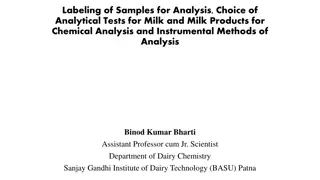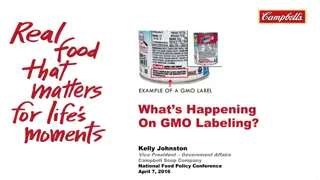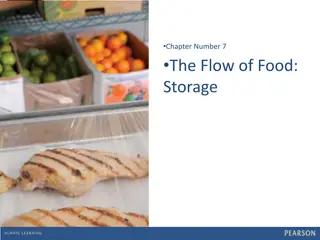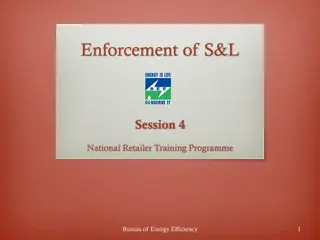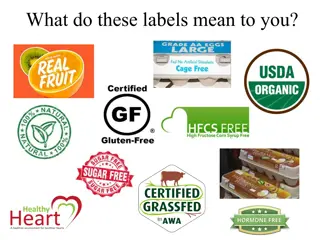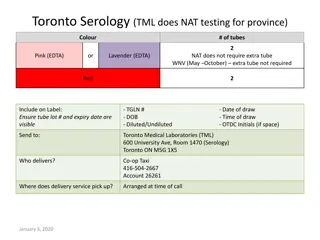Understanding Food Labeling: Essential Information and Guidelines
Food labeling plays a crucial role in informing consumers about the products they buy, including basic details, health and safety information, and marketing aspects. This guide covers what needs to be included on a label, the functions of a label, common requirements, and tools available for proper labeling. From product information to allergens and nutrition facts, understanding food labeling ensures compliance with regulations and helps consumers make informed choices.
Download Presentation

Please find below an Image/Link to download the presentation.
The content on the website is provided AS IS for your information and personal use only. It may not be sold, licensed, or shared on other websites without obtaining consent from the author. Download presentation by click this link. If you encounter any issues during the download, it is possible that the publisher has removed the file from their server.
E N D
Presentation Transcript
Food Labelling 101 August 2014 Wolfville , NS
Whats on a label? A label serves three primary functions: 1) Basic product information common name; list of ingredients; net quantity; durable life date; name and address of producer sometimes, grade/quality and country of origin. 2) Health, safety, and nutrition information allergen information nutrition information special dietary use safe storage and handling 3) Marketing, Promotion and Advertising 2
What needs a label? Primarily, 2 Acts manage food labelling: Food and Drugs Act (FDA) Consumer Packaging and Labelling Act (CPLA) Also, can have commodity specific requirements Must be truthful and not misleading Most pre-packaged foods Exemptions: Foods for export One bite confections Fresh fruit and veg in clear packaging 3
Whats on the label? Common name Sweeteners Country of Origin Net quantity List of ingredients Allergens Place of Business Date markings Nutrition Facts Bilingual 4
Common Name Common name prescribed in regulations Ie. Milk chocolate, cream cheese Shown of Principle Display Panel (PDP) minimum size 1/16 inch for small o Exempt Fresh fruit and veg which is clearly visible Can use variety name ie MacIntosh 7
Net Quantity Net quantity shown as: Weight Volume Count Metric units Font size based on PDP size; bigger the label, the larger the font 8
Ingredient list Required for prepackaged foods with more than one ingredient Exemptions Products packaged at retail ie bulk Single serve packages of condiments Meat and poultry cooked at retail Standardized alcohol beverages Standardized vinegars List in descending order of proportion by weight Components declared 9
Allergens Allergens must be declared, and source must be named Indicated in ingredient list or a contains statement Priority allergens: Eggs, milk, mustard, peanuts, seafood, sulphites, sesame, soy, tree nuts and wheat and cereal grains containing gluten. Exemptions: If exempt from having a label under FDA 10
Place of Business Declare the identity and principal place of business of the person who has produced the food Identity: business name or owner Place of business: physical location where food has been produced Exemptions: Fresh fruit and veg packaged at retail One-bite confections 11
Date Markings Prepackaged product with <91 days shelf life (other stores) Best before date Storage instructions if beyond normal room temp. Prepackaged at retail with <91 days shelf life (in store) Packaged on date durable life on the label or displayed next to the food Exemptions: Prepackaged fresh fruits and veg Prepackaged individual portions at food service Prepackaged donuts. 12
Nutrition Facts Mandatory for MOST prepackaged foods Exemptions: One bite confection Prepackaged single serve portion at food service Milk in refillable glass containers No nutritive value ie. Tea, spices, bottled water Fresh fruit and veg Raw single ingredient meat and poultry except ground Raw single ingredient fish Foods prepared at retail from ingredients ie BBQ chicken Foods sold by producer at street markets 13
Nutrition Facts Mandatory Information 14
Nutrition Facts Prescribed formats: Based on size of available display surface how is food eaten Example formats: Standard, horizontal, linear Simplified ie >7 nutrients = 0 eg. diet soda, drink mix powder Dual ie food needing preparation eg. breakfast cereal Aggregated ie assorted products same package eg. granola bars 15
Non-standard formats Simplified Linear 16
Bilingual All mandatory information in both languages except place of business which can be either EN/FR Exemptions: Shipping Containers: commercial, not meant for consumers Specialty Foods: imported foods with no local substitute Local Foods: Sold in home municipal unit Test Market Foods 17
Sweeteners Use of artificial sweeteners, triggers special labelling requirements Additional statements along with ingredient list and Nutrition Facts 18
Country of Origin (COOL) COOL is required for: wine and brandy dairy products honey fish and fish products fresh fruits and vegetables shelled egg processed egg meat products maple products processed fruit and vegetable products 19
Product of Canada (PoC) Product of Canada = virtually all major ingredients, processing, and labour used to make the food product are Canadian Made in Canada (MiC) requires a qualifying statement MiC with imported ingredients MiC with imported and domestic ingredients Canadian and 100% Canadian same standard as PoC 20
Thank you Find more information at: http://www.inspection.gc.ca/food/labelling/labelling-legislative- framework/eng/1387771371233/1387771427304 http://www.inspection.gc.ca/food/labelling/food-labelling-for- industry/eng/1383607266489/1383607344939 Darren Leyte Health Canada Darren.leyte@hc-sc.gc.ca 902-426-6129 21


